Effects of Defects on Masonry Confinement with Inorganic Matrix Composites
Abstract
:1. Introduction
2. Research Significance
3. Effect of Defects on FRCM Behavior
3.1. Matrix Behavior
3.2. Dry Fiber Behavior
3.3. FRCM Behavior
4. Proposed Theoretical Approach
4.1. Stress vs. Strain Relationship with Confinement
4.2. Lateral-to-Axial Strain Relationship in the Confined Material
4.3. Incremental Approach
5. Experimental Validation and Discussion of Proposed Approach
5.1. Outline of Past Experimental Program
5.2. Discussion of Proposed Approach
5.3. Experimental Validation
6. Conclusions
Author Contributions
Funding
Institutional Review Board Statement
Informed Consent Statement
Data Availability Statement
Conflicts of Interest
References
- ACI 549.4R-13; Guide to Design and Construction of Externally Bonded Fabric-Reinforced Cementitious Matrix (FRCM) Systems for Repair and Strengthening Concrete and Masonry Structures. ACI Committee: Farmington Hill, MI, USA, 2013.
- AC434; Acceptance Criteria for Masonry and Concrete Strengthening Using Fabric-Reinforced Cementitious Matrix (FRCM) and Steel Reinforced Grout (SRG) Composite Systems. International Code Council Evaluation Service: Whittier, CA, USA, 2018.
- CNR-DT 215/2018; Guide for the Design and Construction of Externally Bonded Fibre Reinforced Inorganic Matrix Systems for Strengthening Existing Structures. National Research Council: Rome, Italy, 2020.
- Koutas, L.N.; Tetta, Z.; Bournas, D.A.; Triantafillou, T.C. Strengthening of Concrete Structures with Textile Reinforced Mortars: State-of-the-Art Review. J. Compos. Constr. 2019, 23, 03118001. [Google Scholar] [CrossRef]
- ICOMOS/Iscarsah Committee. Recommendations for the Analysis, Conservation and Structural Restoration of Architectural Heritage. 2005. Available online: www.icomos.org (accessed on 22 May 2023).
- Valluzzi, M.R. Challenges and perspectives for the protection of masonry structures in historic centers: The role of innovative materials and techniques. RILEM Tech. Lett. 2016, 1, 45–49. [Google Scholar] [CrossRef]
- Papanicolaou, C.G.; Triantafillou, T.C.; Papathanasiou, M.; Karlos, K. Textile reinforced mortar (TRM) versus FRP as strengthening material of URM walls: Out-of-plane cyclic loading. Mater. Struct. 2008, 41, 143–157. [Google Scholar] [CrossRef]
- Lignola, G.P.; Bilotta, A.; Ceroni, F. Assessment of the effect of FRCM materials on the behaviour of masonry walls by means of FE models. Eng. Struct. 2019, 184, 145–157. [Google Scholar] [CrossRef]
- Babatunde, S.A. Review of strengthening techniques for masonry using fiber reinforced polymers. Compos. Struct. 2017, 161, 246–255. [Google Scholar] [CrossRef]
- Antonela Moretić, A.; Stepinac, M.; Paulo, B.; Lourenço, P.B. Seismic upgrading of cultural heritage—A case study using an educational building in Croatia from the historicism style. Case Stud. Constr. Mater. 2022, 17, e01183. [Google Scholar] [CrossRef]
- CNR-DT 200 R1/2013; Guide for the Design and Construction of Externally Bonded FRP Systems for Strengthening Existing Structures. National Research Council: Rome, Italy, 2014.
- Federal Emergency Management Agency. Seismic Rehabilitation of Existing Buildings; ASCE/SEI 41-13; American Society of Civil Engineers: Reston, VA, USA, 2013. [Google Scholar]
- 440.7R-10Guide for design and construction of externally bonded FRP systems for strengthening unreinforced masonry structures American Concrete Institute. ACI Committee: Farmington Hills, MI, USA, 2010.
- International Federation for Structural Concrete (FIB). Externally Applied FRP Reinforcement for Concrete Structures; fib Bulletin 90; International Federation for Structural Concrete (FIB): Lausanne, Switzerland, 2019. [Google Scholar]
- Fossetti, M.; Minafò, G. Comparative experimental analysis on the compressive behaviour of masonry columns strengthened by FRP, BFRCM or steel wires. Compos. B Eng. 2017, 112, 112–124. [Google Scholar] [CrossRef]
- Incerti, A.; Vasiliu, A.; Ferracuti, B.; Mazzotti, C. Uniaxial compressive tests on masonry columns confined by FRP and FRCM. In Proceedings of the 12th International Symposium on Fiber Reinforced Polymers for Reinforced Concrete Structures and the 5th Asia-Pacific Conference on Fiber Reinforced Polymers in Structures, Joint Conference, Nanjing, China, 14–16 December 2015. [Google Scholar]
- Ramaglia, G.; Lignola, G.P.; Fabbrocino, F.; Prota, A. Numerical Investigation of Masonry Strengthened with Composites. Polymers 2018, 10, 334. [Google Scholar] [CrossRef] [Green Version]
- Kouris, L.A.S.; Triantafillou, T.C. State-of-the-art on strengthening of masonry structures with textile reinforced mortar (TRM). Constr. Build. Mater. 2018, 188, 1221–1233. [Google Scholar] [CrossRef]
- De Felice, G.; Aiello, M.A.; Caggegi, C.; Ceroni, F.; De Santis, S.; Garbin, E.; Gattesco, N.; Hojdys, Ł.; Krajewski, P.; Kwiecien, A.; et al. Recommendation of RILEM Technical Committee 250-CSM: Test method for Textile Reinforced Mortar to substrate bond characterization. Mater. Struct. 2018, 51, 95. [Google Scholar] [CrossRef]
- Carozzi, F.G.; Bellini, A.; D’Antino, T.; de Felice, G.; Focacci, F.; Hojdys, Ł.; Laghi, L.; Lanoye, E.; Micelli, F.; Panizza, M.; et al. Experimental investigation of tensile and bond properties of Carbon-FRCM composites for strengthening masonry elements. Compos. B Eng. 2017, 128, 100–119. [Google Scholar] [CrossRef]
- Leone, M.; Aiello, M.A.; Balsamo, A.; Carozzi, F.G.; Ceroni, F.; Corradi, M.; Gams, M.; Garbin, E.; Gattesco, N.; Krajewski, P.; et al. Glass fabric reinforced cementitious matrix: Tensile properties and bond performance on masonry substrate. Compos. B Eng. 2017, 127, 196–214. [Google Scholar] [CrossRef] [Green Version]
- Caggegi, C.; Carozzi, F.G.; De Santis, S.; Fabbrocino, F.; Focacci, F.; Hojdys, Ł.; Lanoye, E.; Zuccarino, L. Experimental analysis on tensile and bond properties of PBO and aramid fabric reinforced cementitious matrix for strengthening masonry structures. Compos. B Eng. 2017, 127, 175–195. [Google Scholar] [CrossRef]
- Aiello, M.; Bencardino, F.; Cascardi, A.; D’Antino, T.; Fagone, M.; Frana, I.; La Mendola, L.; Lignola, G.P.; Mazzotti, C.; Micelli, F.; et al. Masonry columns confined with fabric reinforced cementitious matrix (FRCM) systems: A round robin test. Constr. Build. Mater. 2021, 298, 123816. [Google Scholar] [CrossRef]
- Cascardi, A.; Aiello, M.A.; Triantafillou, T. Analysis-oriented model for concrete and masonry confined with fiber reinforced mortar. Mater. Struct. 2017, 50, 202. [Google Scholar] [CrossRef]
- Cascardi, A.; Longo, F.; Micelli, F.; Aiello, M.A. Compressive strength of confined column with Fiber Reinforced Mortar (FRM): New design-oriented-models. Constr. Build. Mater. 2017, 156, 387–401. [Google Scholar] [CrossRef]
- Balsamo, A.; Cascardi, A.; Di Ludovico, M.; Aiello, M.A.; Morandini, G. Analytical study on the effectiveness of the FRCM-confinement of masonry columns. In Proceedings of the Construction Pathology, Rehabilitation Technology and Heritage Management, Cáceres, Spain, 15–18 May 2018. [Google Scholar]
- Murgo, F.S.; Mazzotti, C. Masonry columns strengthened with FRCM system: Numerical and experimental evaluation. Constr. Build. Mater. 2019, 2019, 208–222. [Google Scholar] [CrossRef]
- Krevaikas, T.D. Experimental study on carbon fiber textile reinforced mortar system as a means for confinement of masonry columns. Constr. Build. Mater. 2019, 208, 723–733. [Google Scholar] [CrossRef]
- Carloni, C.; Mazzotti, C.; Savoia, M.; Subramaniam, K.V. Confinement of masonry columns with PBO FRCM composites. Key Eng. Mater. 2014, 624, 644–651. [Google Scholar] [CrossRef]
- Fossetti, M.; Minafò, G. Strengthening of masonry columns with BFRCM or with steel wires: An experimental study. Fibers 2016, 4, 15. [Google Scholar] [CrossRef] [Green Version]
- Witzany, J.; Zigler, R. Stress state analysis and failure mechanisms of masonry columns reinforced with FRP under concentric compressive load. Polymers 2016, 8, 176. [Google Scholar] [CrossRef] [Green Version]
- Ombres, L.; Verre, S. Masonry columns strengthened with Steel Fabric Reinforced Cementitious Matrix (S-FRCM) jackets: Experimental and numerical analysis. Measurement 2018, 127, 238–245. [Google Scholar] [CrossRef]
- Mezrea, P.E.; Yilmaz, I.A.; Ispir, M.; Binbir, E.; Bal, I.E.; Ilki, A. External jacketing of unreinforced historical masonry piers with open-grid basalt-reinforced mortar. J. Compos. Constr. 2016, 21, 04016110. [Google Scholar] [CrossRef]
- Maddaloni, G.; Cascardi, A.; Balsamo, A.; di Ludovico, M.; Micelli, F.; Aiello, M.A.; Prota, A. Confinement of fullscale masonry columns with FRCM systems. Key Eng. Mater. 2017, 747, 374–381. [Google Scholar] [CrossRef]
- Cascardi, A.; Micelli, F.; Aiello, M.A. FRCM-confined masonry columns: Experimental investigation on the effect of the inorganic matrix properties. Constr. Build. Mater. 2018, 186, 811–825. [Google Scholar] [CrossRef]
- Ombres, L.; Verre, S. Analysis of the Behavior of FRCM Confined Clay Brick Masonry Columns. Fibers 2020, 8, 11. [Google Scholar] [CrossRef] [Green Version]
- Ameli, Z.; D’Antino, T.; Carloni, C. A new predictive model for FRCM-confined columns: A reflection on the composite behavior at peak stress. Constr. Build. Mater. 2022, 337, 127534. [Google Scholar] [CrossRef]
- Bilotta, A.; Lignola, G.P. Effects of Defects on Bond Behavior of Fiber Reinforced Cementitious Matrix Materials. Materials 2020, 13, 164. [Google Scholar] [CrossRef] [Green Version]
- De Felice, G.; D’Antino, T.; de Santis, S.; Meriggi, P.; Roscini, F. Lessons learned on the tensile and bond behavior of fabric reinforced cementitious matrix (FRCM) composites. Front. Built Environ. 2020, 6, 5. [Google Scholar] [CrossRef]
- De Domenico, D.; Quattrocchi, A.; Alizzio, D.; Montanini, R.; Urso, S.; Ricciardi, G.; Recupero, A. Experimental Characterization of the FRCM-Concrete Interface Bond Behavior Assisted by Digital Image Correlation. Sensors 2021, 21, 1154. [Google Scholar] [CrossRef]
- Bilotta, A.; Lignola, G.P. Effect of fiber-to-matrix bond on the performance of inorganic matrix composites. Compos. Struct. 2021, 265, 113655. [Google Scholar] [CrossRef]
- Rots, J.G.; Nauta, P.; Kusters, G.M.A.; Blaawendraad, J. Smeared crack approach and fracture localization in concrete. HERON 1985, 30, 1–48. [Google Scholar]
- Popovics, S. A numerical approach to the complete stress-strain curves for concrete. Cement Conor. Res. 1973, 3, 583–599. [Google Scholar] [CrossRef]
- Teng, J.G.; Huang, Y.L.; Lam, L.; Ye, L.P. Theoretical model for fiber reinforced polymer-confined concrete. ASCE J. Compos. Constr. 2007, 11, 201–210. [Google Scholar] [CrossRef]
- Lignola, G.P.; Prota, A.; Manfredi, G. Simplified Modeling of Rectangular Concrete Cross-Sections Confined by External FRP Wrapping. Polymers 2014, 6, 1187–1206. [Google Scholar] [CrossRef] [Green Version]
- Lignola, G.P.; Prota, A.; Manfredi, G. Influence of masonry properties on confinement: A mechanical model. Key Eng. Mater. 2014, 624, 299–306. [Google Scholar] [CrossRef]
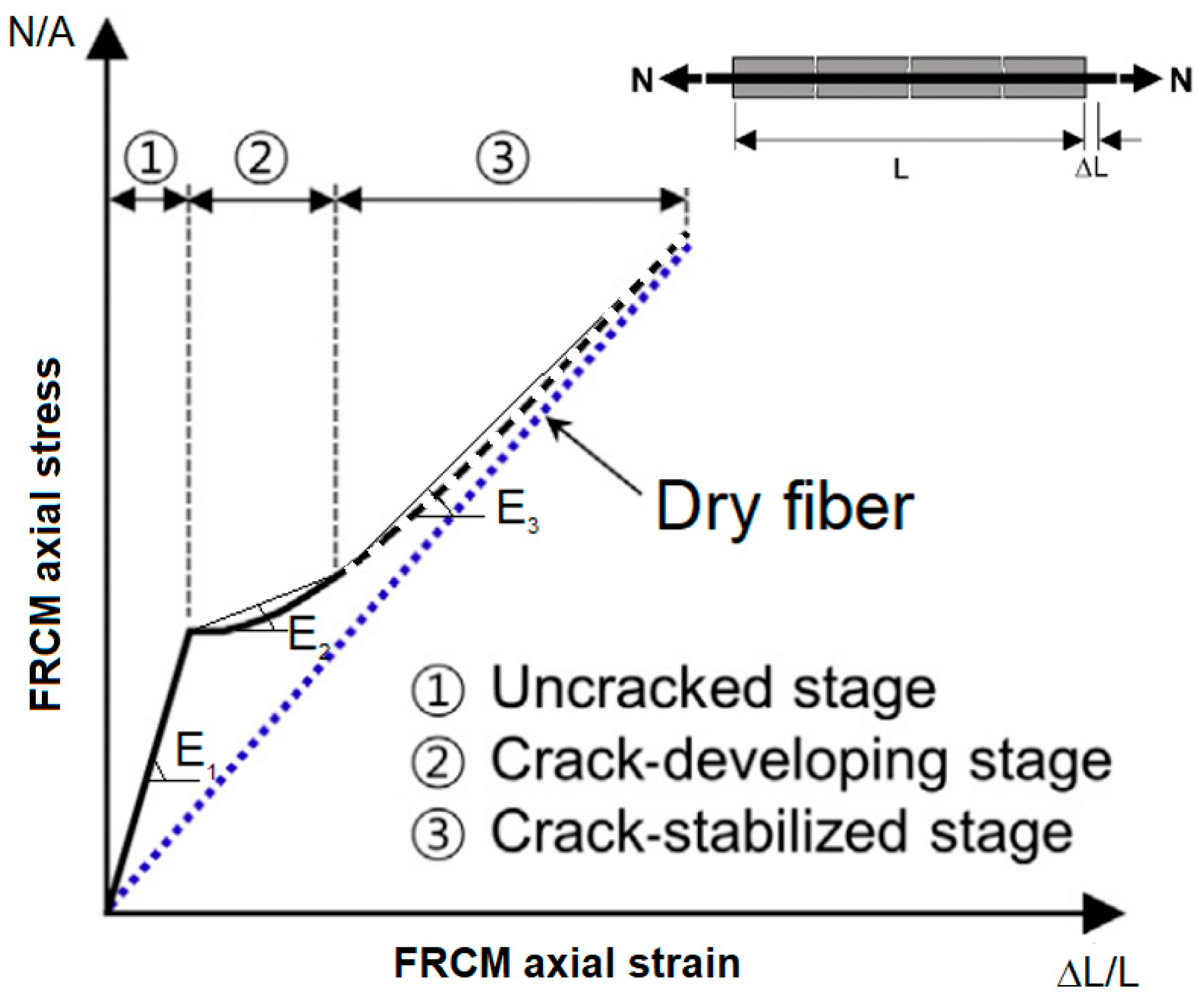

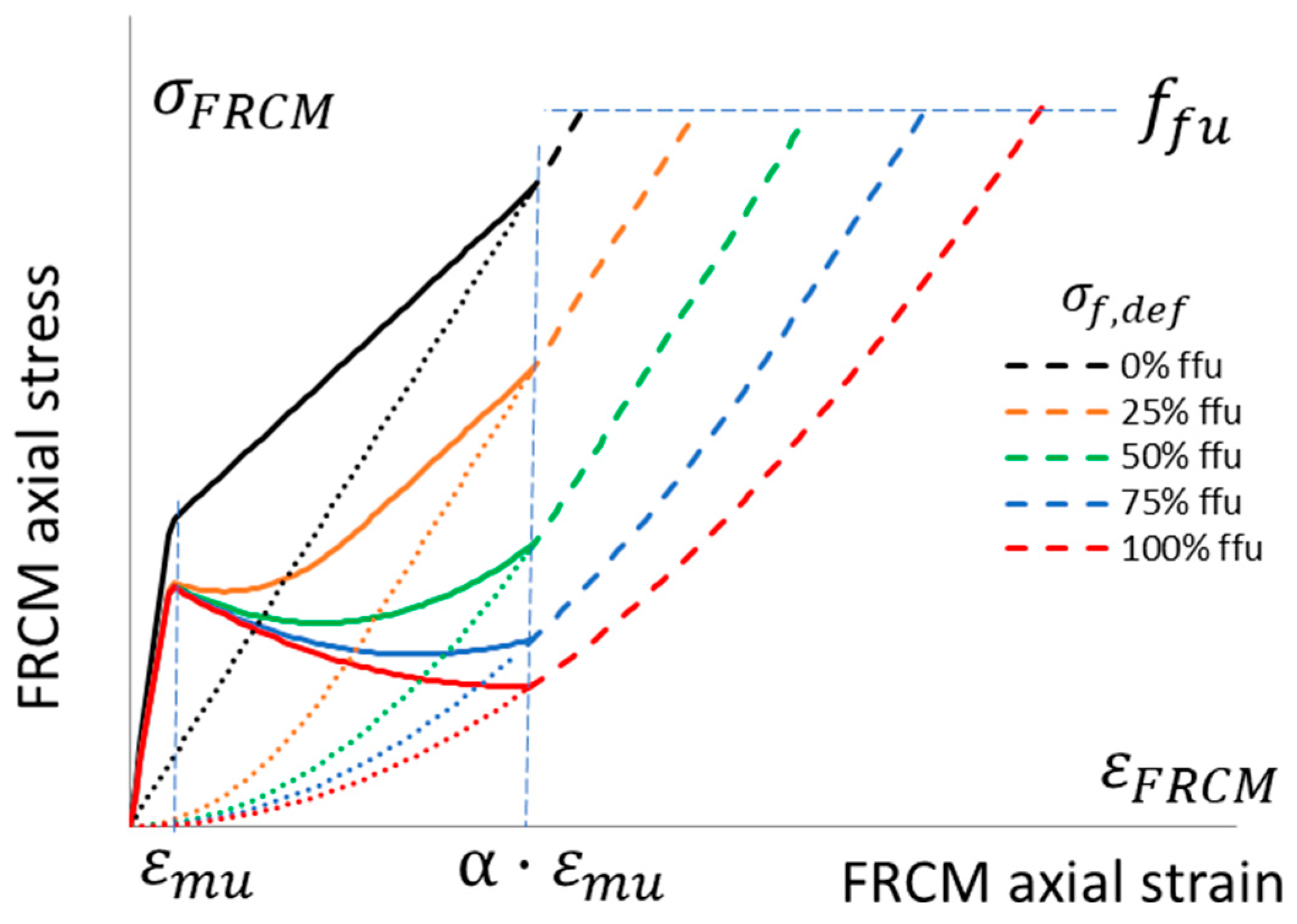

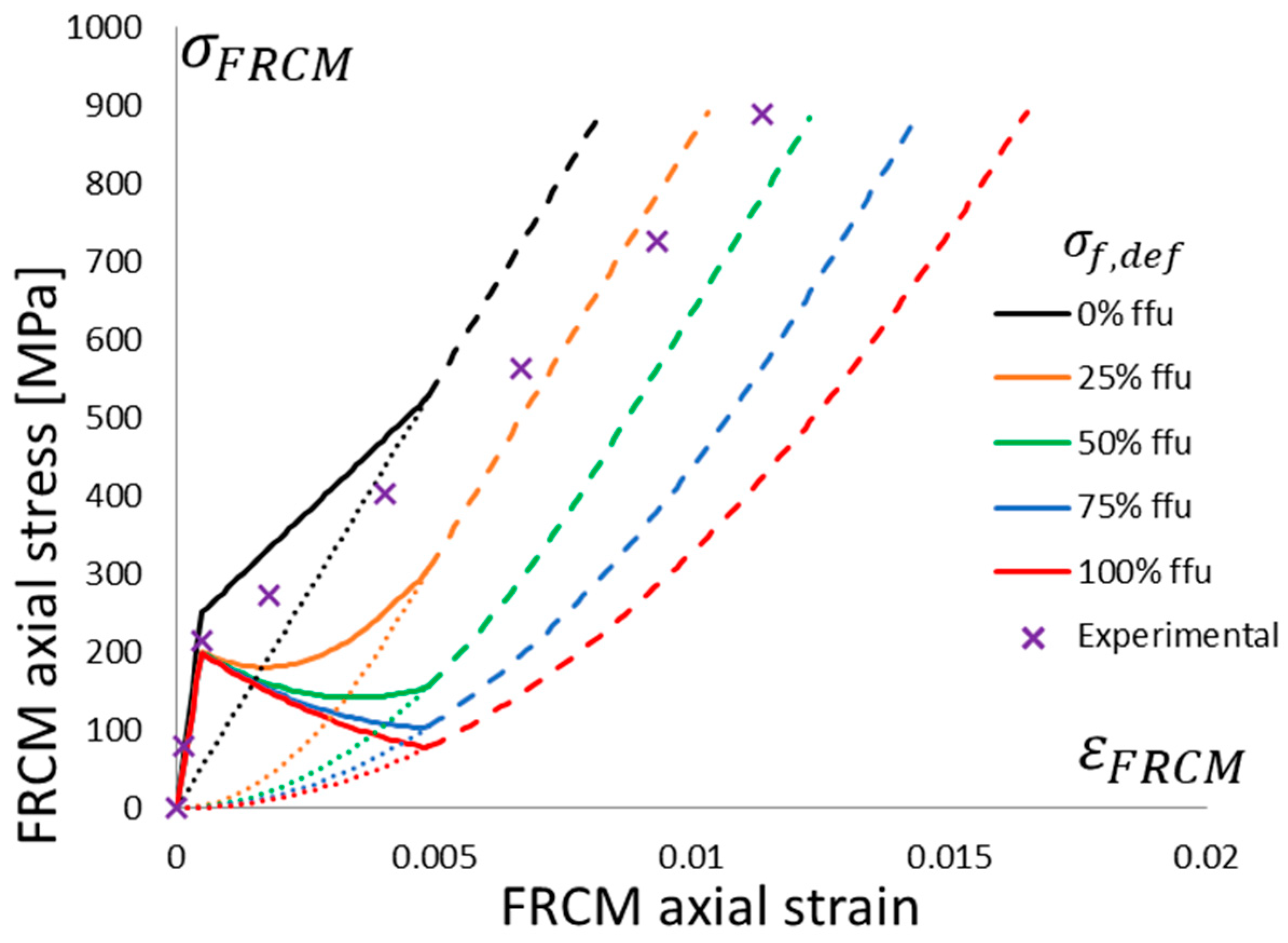
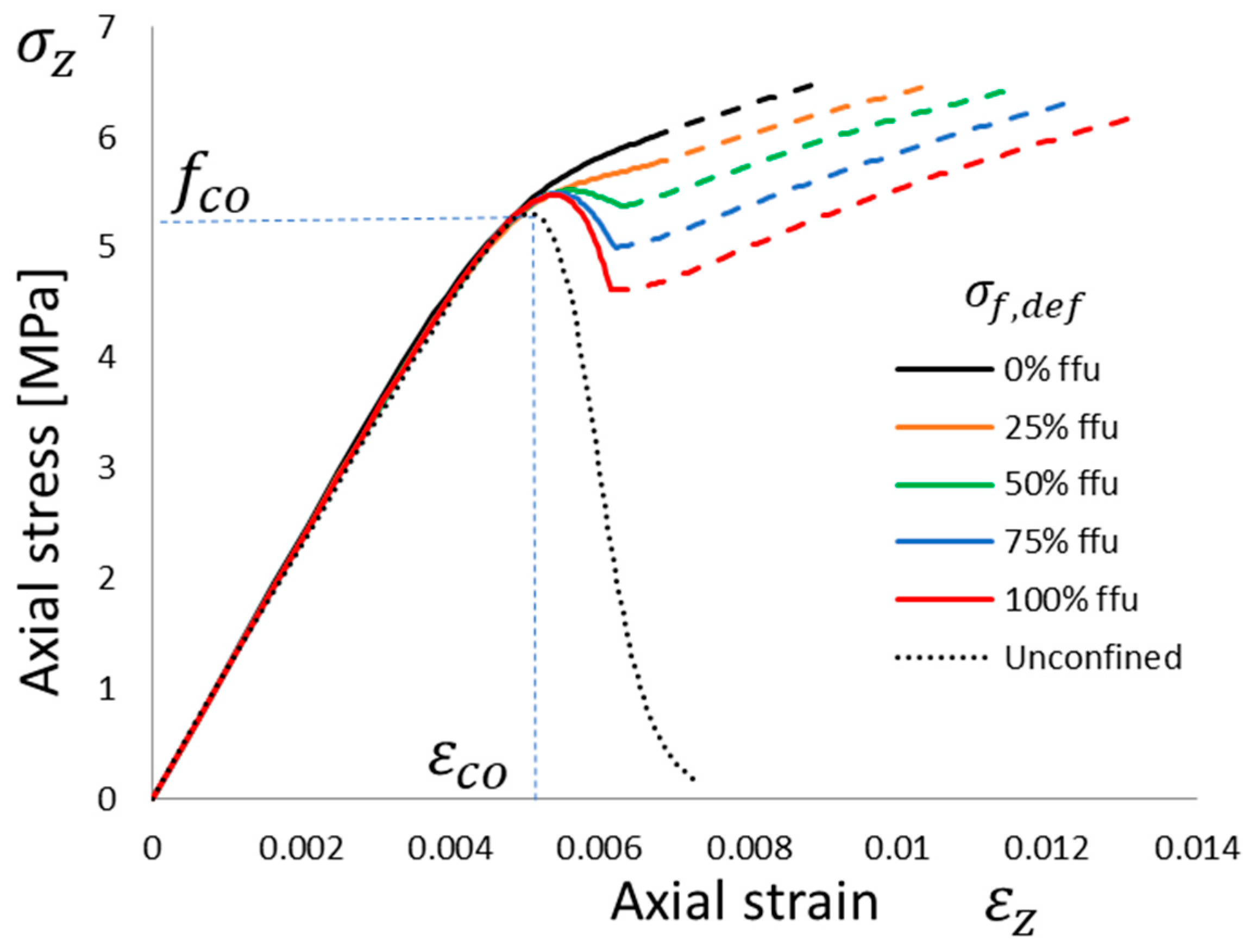


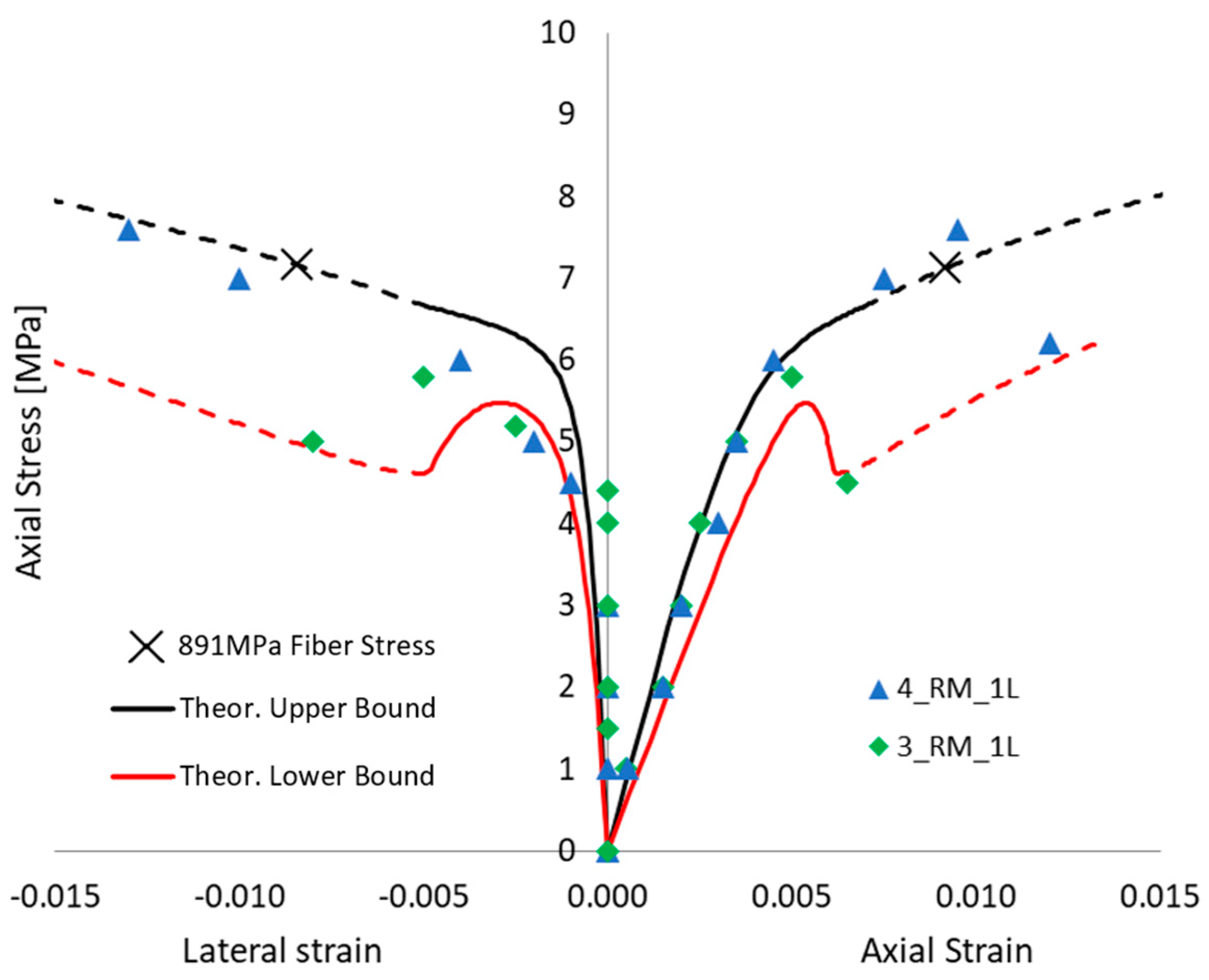

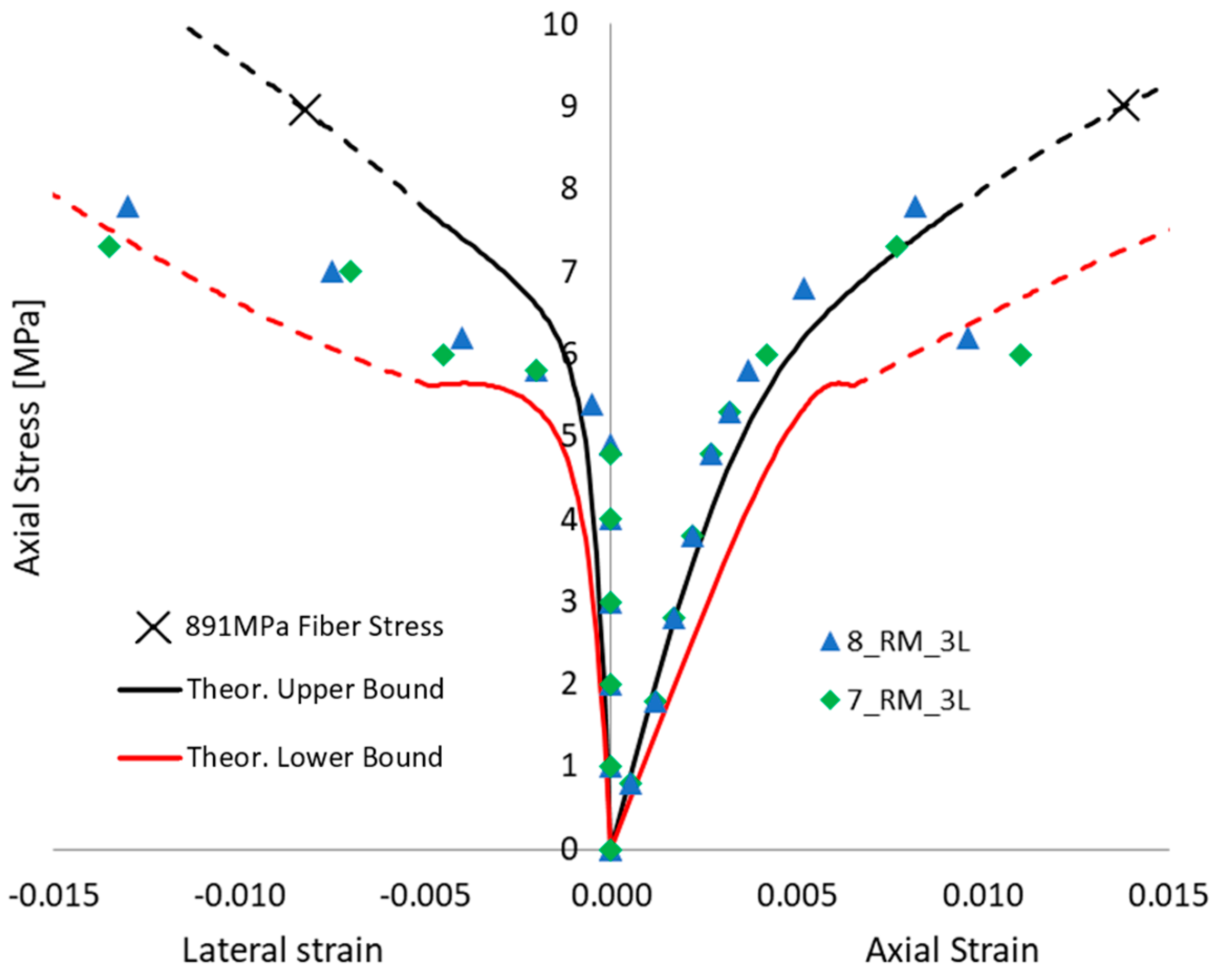
| Property | Mean Value | CoV |
|---|---|---|
| E1 | 514.5 GPa | 0.08 |
| E2 | 77.5 GPa | 0.05 |
| ffu | 891 MPa | 0.15 |
| εfu | 9.7 mm/m | 0.19 |
| Ef | 108.0 GPa | 0.16 |
| fmc | 9.1 MPa | 0.27 |
| ID | Max. Axial Stress (MPa) | Max. Axial Strain (mm/m) | Elastic Modulus (MPa) |
|---|---|---|---|
| 1_URM | 5.93 | 4.6 | 1674 |
| 2_URM | 5.31 | 4.7 | 1173 |
| 3_RM_1L | 5.57 | 4.1 | 2202 |
| 4_RM_1L | 7.67 | 6.6 | 1858 |
| 5_RM_2L | 5.66 | 5.5 | 2254 |
| 6_RM_2L | 5.88 | 5.3 | 2755 |
| 7_RM_3L | 7.39 | 7.7 | 2926 |
| 8_RM_3L | 8.04 | 7.9 | 2669 |
Disclaimer/Publisher’s Note: The statements, opinions and data contained in all publications are solely those of the individual author(s) and contributor(s) and not of MDPI and/or the editor(s). MDPI and/or the editor(s) disclaim responsibility for any injury to people or property resulting from any ideas, methods, instructions or products referred to in the content. |
© 2023 by the authors. Licensee MDPI, Basel, Switzerland. This article is an open access article distributed under the terms and conditions of the Creative Commons Attribution (CC BY) license (https://creativecommons.org/licenses/by/4.0/).
Share and Cite
Lignola, G.P.; Manfredi, G.; Prota, A. Effects of Defects on Masonry Confinement with Inorganic Matrix Composites. Materials 2023, 16, 4737. https://doi.org/10.3390/ma16134737
Lignola GP, Manfredi G, Prota A. Effects of Defects on Masonry Confinement with Inorganic Matrix Composites. Materials. 2023; 16(13):4737. https://doi.org/10.3390/ma16134737
Chicago/Turabian StyleLignola, Gian Piero, Gaetano Manfredi, and Andrea Prota. 2023. "Effects of Defects on Masonry Confinement with Inorganic Matrix Composites" Materials 16, no. 13: 4737. https://doi.org/10.3390/ma16134737





